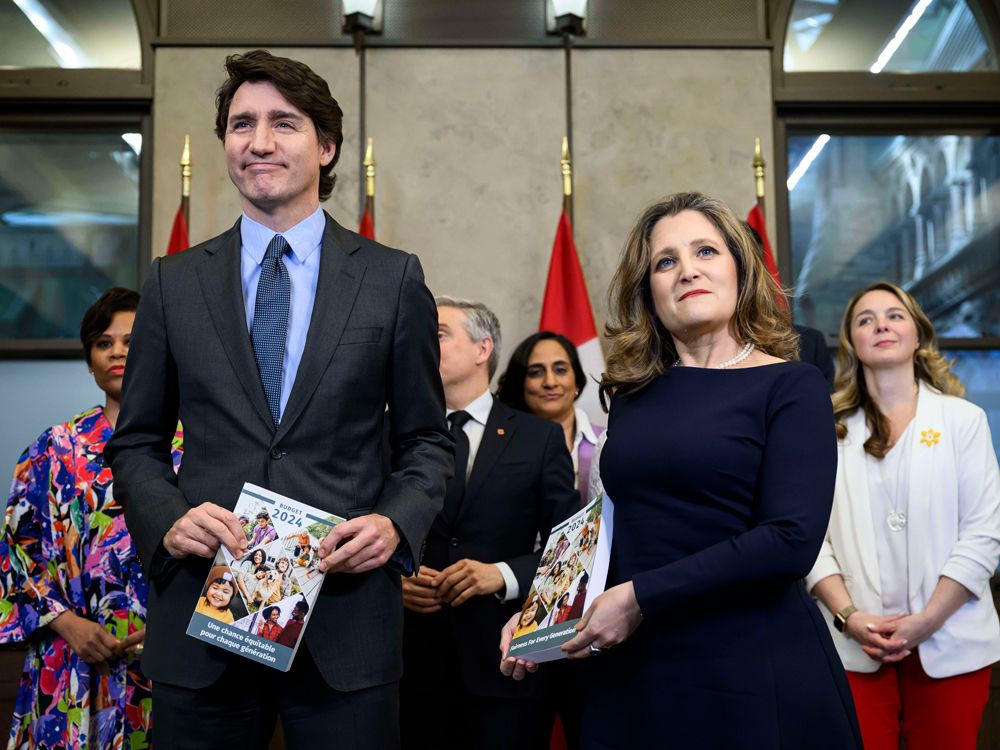Economy
Canada's Conservatives hammer Trudeau on slowing economy ahead of vote – Reuters
/cloudfront-us-east-2.images.arcpublishing.com/reuters/32PGCCH3TJLGXNBPU2YP3VXARU.jpg)
/cloudfront-us-east-2.images.arcpublishing.com/reuters/32PGCCH3TJLGXNBPU2YP3VXARU.jpg)
A construction crane is seen above Brookfield’s Bay Adelaide North, the third office tower to be constructed at their Bay Adelaide Centre complex property in Toronto, Ontario, Canada April 14, 2021. Picture taken April 14, 2021. REUTERS/Chris Helgren
OTTAWA, Aug 31 (Reuters) – Canada’s Conservatives hammered Liberal Prime Minister Justin Trudeau on Tuesday after data showed that the country’s economy unexpectedly shrank in the second quarter and again in July, putting the economy at the center of debate three weeks ahead of a national election.
Canada is the only Group of Seven country to record a deceleration in the second quarter, according to an OECD report.
“Canada’s economy is getting worse, not better,” Conservative leader Erin O’Toole said from his Ottawa headquarters. “Under Justin Trudeau we are heading further down the road of recession, not the road to recovery.”
Canada’s economy shrank 1.1% in the second quarter on an annualized basis, missing analyst expectations of a gain of 2.5%, Statistics Canada data showed. A preliminary estimate for July showed a contraction of 0.4%, while June GDP rose 0.7%, in line with expectations.
With the July decline, economic activity remains about 2% below pre-pandemic levels, Statscan said.
“It’s a jaw-dropper,” said Doug Porter, chief economist at BMO Capital Markets, adding: “It will probably be an uncomfortable question for the government today but I don’t think the GDP number will have a huge impact on the elections.”
Trudeau’s Liberals are currently tied with the Conservatives at 33% ahead of the Sept 20 federal election, according a new Nanos Research poll. The left-leaning New Democrats have 19%.
Polls have shown that the economy is one of the top concerns of Canadians heading into the vote.
Statscan said the second-quarter drop was mostly driven by declines in home sales and exports. Housing investment boomed during the pandemic, helping drive the economic rebound from the crisis, but the market has cooled from its March peak.
The likely contraction in July, which comes even as most provinces loosened COVID-19 restrictions, was driven by decreases in manufacturing, construction and retail trade, said Statscan. The outlook has been further clouded by a surge in new COVID-19 infections, mostly among the unvaccinated.
Economists said the GDP miss could impact the timing of Bank of Canada policy tightening, though hot inflation and a strong August could also sway the picture.
The central bank last month said it expected Canada’s economy to gain 2.0% in the second quarter, with growth picking up “strongly” in the third quarter as more services reopened. It will put out new forecasts in October.
“It comes in weaker than their expectations,” said Jimmy Jean, chief economist at Desjardins Group. “At the same time, we also have to recognize that there will be a major rebound in the third quarter. So all hope is not lost.”
The Canadian dollar was trading 0.2% lower at 1.2620 to the greenback, or 79.24 U.S. cents.
Additional reporting by Fergal Smith in Toronto and Shariq Khan; Editing by Jonathan Oatis, Kevin Liffey and Mark Porter
Our Standards: The Thomson Reuters Trust Principles.
Economy
Canada's budget 2024 and what it means for the economy – Financial Post


THIS CONTENT IS RESERVED FOR SUBSCRIBERS ONLY
Subscribe now to read the latest news in your city and across Canada.
- Exclusive articles from Barbara Shecter, Joe O’Connor, Gabriel Friedman, Victoria Wells and others.
- Daily content from Financial Times, the world’s leading global business publication.
- Unlimited online access to read articles from Financial Post, National Post and 15 news sites across Canada with one account.
- National Post ePaper, an electronic replica of the print edition to view on any device, share and comment on.
- Daily puzzles, including the New York Times Crossword.
SUBSCRIBE TO UNLOCK MORE ARTICLES
Subscribe now to read the latest news in your city and across Canada.
- Exclusive articles from Barbara Shecter, Joe O’Connor, Gabriel Friedman, Victoria Wells and others.
- Daily content from Financial Times, the world’s leading global business publication.
- Unlimited online access to read articles from Financial Post, National Post and 15 news sites across Canada with one account.
- National Post ePaper, an electronic replica of the print edition to view on any device, share and comment on.
- Daily puzzles, including the New York Times Crossword.
REGISTER / SIGN IN TO UNLOCK MORE ARTICLES
Create an account or sign in to continue with your reading experience.
- Access articles from across Canada with one account.
- Share your thoughts and join the conversation in the comments.
- Enjoy additional articles per month.
- Get email updates from your favourite authors.
Economy
Opinion: Canada's economy has stagnated despite Trudeau government spin – Financial Post
Article content
Growth in gross domestic product (GDP), the total value of all goods and services produced in the economy annually, is one of the most frequently cited indicators of economic performance. To assess Canadian living standards and the current health of the economy, journalists, politicians and analysts often compare Canada’s GDP growth to growth in other countries or in Canada’s past. But GDP is misleading as a measure of living standards when population growth rates vary greatly across countries or over time.
Article content
Federal Finance Minister Chrystia Freeland recently boasted that Canada had experienced the “strongest economic growth in the G7” in 2022. In this she echoes then-prime minister Stephen Harper, who said in 2015 that Canada’s GDP growth was “head and shoulders above all our G7 partners over the long term.”
Article content
Unfortunately, such statements do more to obscure public understanding of Canada’s economic performance than enlighten it. Lately, our aggregate GDP growth has been driven primarily by population and labour force growth, not productivity improvements. It is not mainly the result of Canadians becoming better at producing goods and services and thus generating more real income for their families. Instead, it is a result of there simply being more people working. That increases the total amount of goods and services produced but doesn’t translate into increased living standards.
Let’s look at the numbers. From 2000 to 2023 Canada’s annual average growth in real (i.e., inflation-adjusted) GDP growth was the second highest in the G7 at 1.8 per cent, just behind the United States at 1.9 per cent. That sounds good — until you adjust for population. Then a completely different story emerges.
Article content
Over the same period, the growth rate of Canada’s real per person GDP (0.7 per cent) was meaningfully worse than the G7 average (1.0 per cent). The gap with the U.S. (1.2 per cent) was even larger. Only Italy performed worse than Canada.
Why the inversion of results from good to bad? Because Canada has had by far the fastest population growth rate in the G7, an average of 1.1 per cent per year — more than twice the 0.5 per cent experienced in the G7 as a whole. In aggregate, Canada’s population increased by 29.8 per cent during this period, compared to just 11.5 per cent in the entire G7.
Starting in 2016, sharply higher rates of immigration have led to a pronounced increase in Canada’s population growth. This increase has obscured historically weak economic growth per person over the same period. From 2015 to 2023, under the Trudeau government, real per person economic growth averaged just 0.3 per cent. That compares with 0.8 per cent annually under Brian Mulroney, 2.4 per cent under Jean Chrétien and 2.0 per cent under Paul Martin.
Recommended from Editorial
Canada is neither leading the G7 nor doing well in historical terms when it comes to economic growth measures that make simple adjustments for our rapidly growing population. In reality, we’ve become a growth laggard and our living standards have largely stagnated for the better part of a decade.
Ben Eisen, Milagros Palacios and Lawrence Schembri are analysts at the Fraser Institute.
Bookmark our website and support our journalism: Don’t miss the business news you need to know — add financialpost.com to your bookmarks and sign up for our newsletters here.
Share this article in your social network
Economy
Federal budget is about ensuring fair economy for ‘everyone’: Trudeau – Global News


Delivering remarks to his Liberal cabinet during a caucus meeting on Wednesday, Prime Minister Justin Trudeau emphasized that the newly-announced federal government is intended to help create a fair economy for “everyone” in Canada, particularly those from Millennials and Gen Z.
-



 Sports20 hours ago
Sports20 hours agoTeam Canada’s Olympics looks designed by Lululemon
-
News21 hours ago
Richard Chevolleau Short Film “Marvelous Marvin” Set to go to Camera
-
Business19 hours ago
Firefighters battle wildfire near Edson, Alta., after natural gas line rupture – CBC.ca
-



 Tech12 hours ago
Tech12 hours agoiPhone 15 Pro Desperado Mafia model launched at over ₹6.5 lakh- All details about this luxury iPhone from Caviar – HT Tech
-



 Investment22 hours ago
Investment22 hours agoStephen Poloz will lead push to boost domestic investment by Canadian pension funds
-
Art23 hours ago
Richmond art exhibits travel back in time, explore legacies
-
News22 hours ago
Federal budget 2024: Some of the winners and losers
-



 Sports12 hours ago
Sports12 hours agoLululemon unveils Canada's official Olympic kit for the Paris games – National Post








